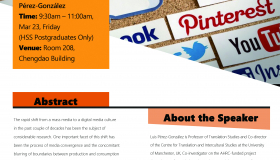学术讲座 | 凸优化
讲座题目:凸优化
时间&日期:2017年2月14日,下午14点至15点
地点:理事会会议室,道远楼
主讲人:Stephen P. Boyd 教授 (Stanford University)
摘要:Convex optimization has emerged as useful tool for applications that include data analysis and model fitting, resource allocation, engineering design, network design and optimization, finance, and control and signal processing. After an overview of the mathematics, algorithms, and software frameworks for convex optimization, we turn to common themes that arise across applications, such as sparsity and relaxation. We describe recent work on real-time embedded convex optimization, in which small problems are solved repeatedly in millisecond or microsecond time frames, and large-scale distributed convex optimization, in which many solvers are coordinated to solve enormous problems.
关于演讲人:Stephen P. Boyd is the Samsung Professor of Engineering, in the Information Systems Laboratory, Electrical Engineering Department, Stanford University. He holds courtesy appointments in the departments of Computer Science and Management Science and Engineering, and is a member of the Institute for Computational Mathematics and Engineering. His current interests include convex programming applications in control, machine learning, signal processing, finance, and circuit design. He received an AB degree in Mathematics, summa cum laude, from Harvard University in 1980, and a PhD in EECS from U. C. Berkeley in 1985. He holds honorary PhDs from Royal Institute of Technology, Stockholm, and Catholic University of Louvain, Belgium. He is the author of many papers and several books, including Convex Optimization (with Lieven Vandenberghe, 2004) and Linear Matrix Inequalities in Systems and Control (with El Ghaoui, Feron, and Balakrishnan). His group has created many open source software packages, including the widely used packages for convex optimization CVX, CVXPY, and Convex.jl, all available at his website, which is visited more than 1.6 million times per year. He is a fellow of IEEE, SIAM, and INFORMS, and a member of the National Academy of Engineering.




